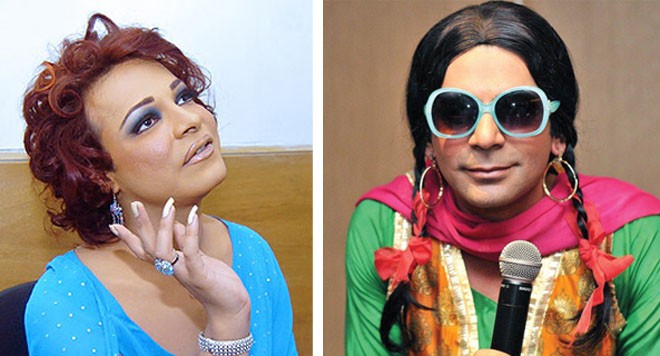
Does comedy have to be demeaning to women? The answer should be an emphatic ‘No’. In the case of TV comedy in the sub-continent, sadly, it is ‘Yes’

The extant works of Greek playwright Aristophanes (fifth century before Christ) are classified as Old Comedy. One of the characteristics of his plays was a rather sexist depiction of women. This comedic structure was later inverted by Shakespeare, whose comedy elevates women to the role of protagonist and heroine.
However, it is to Aristophanes that one must turn in order to understand much of what is being portrayed on TV in the sub-continent in particular today. In the words of Lysistrata, the eponymous heroine of Aristophanes, "There are a lot of things about us women/That sadden me, considering how men/See us as rascals."
Lysistrata appears to be highlighting the flaw in male perceptions of women; however, her neighbour and friend Calonice, a housewife, replies by saying, "As indeed we are!"
Calonice’s attitude is a reflection of what in subsequent centuries has become the scripture-centred approach to gender whereby Eve is not just tempted but is, more damningly, the temptress. This perception of women as inferior beings is, historically, the most potent reason why they have been objectified in literature, historiography and, most importantly in the post-modern world, in mass media.
A phenomenon enacted in parallel across the sub-continent encapsulates how TV drama has been engendered in Pakistan and India.
It seems ironic that a society that is as regressive as ours should be obsessed with men dressed as women as well as transgender characters. From the 1970s onwards, it has been the prerogative and expected job of transgenders, eunuchs, and men in drag to dance near what is known as the ‘maut ka kunwan’ (a well inside which the circus performers ride their motorcycles). It can be argued that a large number of the adult, male spectators visit the circus not for the daredevil act of the motorcyclists but more for the lascivious pelvic thrusts of these dancers who are often cross-dressers, forced to adapt a transgender identity to feed their families.
What needs to be pointed out is that the jeering of the crowds and the responses of the dancers are all factors contributing to the objectification of women. This seemingly ‘harmless’ pastime is, in reality, an encouragement of a repressed tendency to treat women as a commodity.
The manifestation of this obsession can be seen in the not-so-recent popularity of the Begum Nawazish Ali persona on television. Those were the early days of independent TV channels, and with a burgeoning audience, Ali Saleem dressed as a liberal high-society ‘aunty,’ flirting with his male guests with impunity.
Not surprisingly, the ratings of the show topped all possible heights.
A professor of history recently suggested that Begum’s success was a one-off affair, limited to an elitist audience. To me, this is a fallacious argument because restricting this issue to a class-based analysis excludes the wider reality of the ‘maut ka kunwan´ phenomenon which I have discussed earlier. The Begum’s popularity, like the status of the transgender dancers of the circus, is connected with our fondness for men who cross-dress and thus objectify women.
One more example from Pakistan is the case of women and cross-dressing men in popular stage dramas. They get hooted at, which is often, disturbingly, a signal of acceptance by the audience. There have been stage dramas where transgender characters, cross-dressers, and even women have been humiliated in ‘juggat-baazi’, to raucous applause. It is not burlesque or farce that the audience wishes to see; in fact, it is downright bad-taste, slapstick humour.
In India, it is in TV shows like Comedy Nights and The Kapil Sharma Show that the same is exemplified in the many drag characters. When Comedy Nights was hosted by Sharma (regarded as India’s funniest man today), the character of Gutthi, played by the very versatile Sunil Grover, was the most popular of the various characters on the show.
While this has a lot to do with Grover’s outstanding abilities as a character actor, I believe it has more to do with the sub-continent’s infatuation with cross-dressing men. Whereas Gutthi could not be classified as vulgar in the sense of Begum Nawazish Ali, the persona’s sensational triumph is owing to the fact that seeing women in the public space is still a very taboo subject, not just in Pakistan but also in a more-secular India.
When the show shifted to a new channel under the title of The Kapil Sharma Show, Grover claimed on the show’s launch in Delhi that he was now playing a male character. When the question was put to a poll, the entire hall raised their hands to support Sharma’s insistence that Grover should play a woman. So, the audience, male and female, desires to see a man dressed as a woman. Grover, as a result, now plays Rinku Bhabhi, a simple village woman.
What needs to be reiterated and underscored is the fact that an educated, Westernised Delhi audience unanimously voted to see a man dress up as a woman and perform antics that a woman would normally find demeaning.
If the link between this popular character and the objectification of women is not clear from the above example, the same show is known for two characters played by actor Ali Asghar, who is widely considered one of the most vulgar comedians on Indian TV. One of the characters he plays is called ‘Begum Luchi’, a sobriquet that may variously be translated as lascivious, vulgar, and naughty, among other possible translations.
Asghar’s persona often tries to sit in the laps of the male guests, invites them in the most provocative fashion, and is obviously meant to increase the ratings of the show. Not one audience member seems to have any objections.
Does comedy have to be demeaning to women? The answer should be an emphatic ‘No’. In the case of TV comedy in the sub-continent, sadly, it is ‘Yes’.